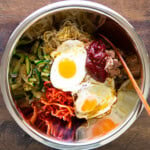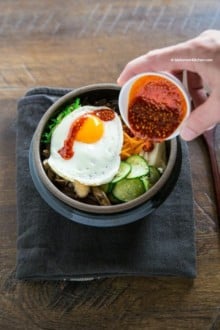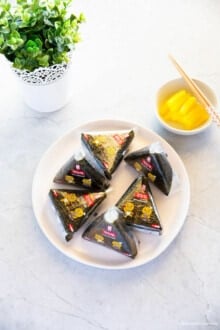Yangpun Bibimbap is a versatile and flavorful dish that fits perfectly into busy lifestyles. It’s all about convenience—fewer dishes to wash, using up leftovers from the fridge, and being able to whip it up quickly.
We love making this at home because it’s a great way to clean out older vegetables or Korean side dishes, and it’s easy to prepare. But most importantly, it’s delicious. Do you want to learn how to make it?
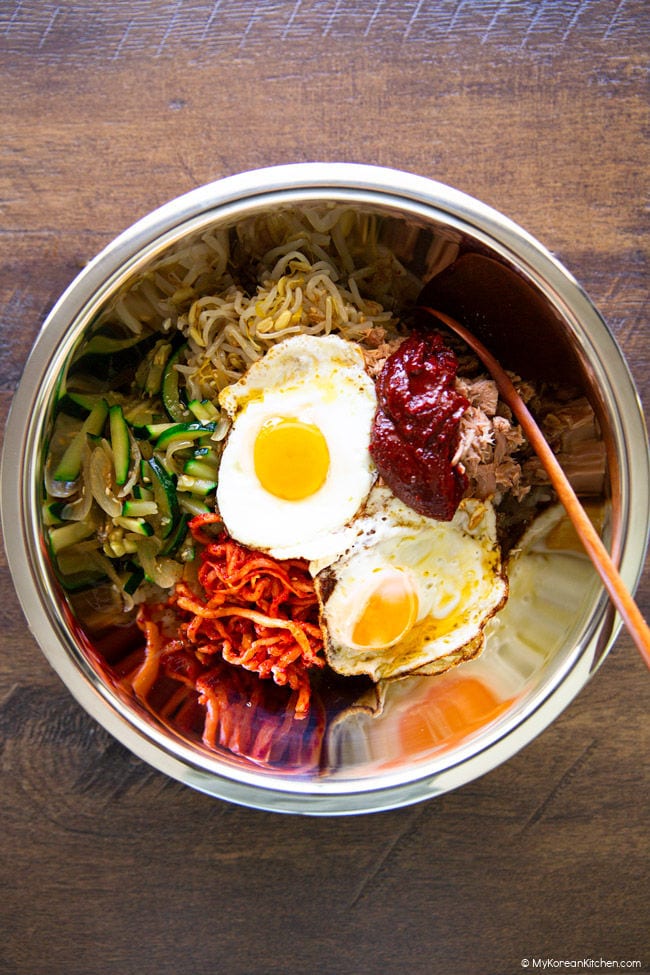
What is Yangpun Bibimbap?
“Yangpun” (양푼) originally referred to a large brass bowl, but these days it also describes stainless steel bowls in a Korean kitchen. Its large, shallow design with a wide opening makes it perfect for preparing ingredients, rinsing, combining, and serving communal meals such as yangpun bibimbap.
In case you’re not aware, the signature Korean dish “bibimbap” (비빔밥) is mixed rice with various vegetables, meat, and specially made gochujang sauce. Therefore, yangpun bibimbap refers to this delicious dish served in a yangpun bowl.
I really wanted to get my hands on a large brass bowl to show you, but I couldn’t source one where I live. Instead, I managed to get a large stainless steel bowl, which was perfect for this meal. But at the end of the day, you can use whatever bowl you have for this recipe to work.
A Delicious Star in Your Favorite K-Dramas and Movies
If you’re an avid K-drama or movie fan, you might notice yangpun bibimbap (양푼 비빔밥) showing up quite often. It usually pops up when a character is feeling lonely, depressed, or stressed. You’ll typically see them in loose track pants and a T-shirt, with their hair in a funny bun for that laid-back at-home vibe. They’ll take out all the pre-made Korean side dishes, rice and gochujang, throw everything into the bowl, and mix it all together.
In other K-drama scenes (like Queen of Tears, 2024, episode 10), you’ll spot this bibimbap served in a big bowl for the whole family. All the ingredients are mixed in this huge bowl, and everyone digs in with their spoons, enjoying the meal together until it’s all gone. Sometimes, you even fight for the last spoonful of rice. This really brings back nostalgic memories for me.
If you want to take part in this communal Korean food culture, you should give this recipe a try with your friends or family members. You can also enjoy it solo in a small bowl too, of course.

List of Banchan Perfect for Your Next Yangpun Bibimbap
When it comes to yangpun bibimbap ingredients, I take a very casual approach. Obviously, rice and the sauce is a must, but for vegetables, any Korean side dishes or vegetables can go in, unlike the more traditional bibimbap.
If you’ve already made some Korean side dishes, you can just toss them into the bowl. And if you’re feeling lazy, you can even buy pre-made side dishes from a Korean grocery store or a banchan shop. Below are some common Korean side dishes that go into bibimbap. Click the hyperlink to get the recipe.
- Gosari Namul (Korean Fernbrake Side Dish, 고사리 나물)
- Sigeumchi Namul (Korean Spinach Salad, 시금치 나물)
- Sukju Namul (Korean Bean Sprout Salad, 숙주 나물)
- Oi Namul (Sautéed Cucumber, 오이 나물)
- Oi Muchim (Spicy Korean Cucumber, 오이무침)
- Musaengchae (Korean Radish Salad, 무생채)
- Gamja Bokkeum (Korean Potato Stir Fry, 감자볶음)
- Hobak Bokkeum (Korean Zucchini Stir Fry, 호박 볶음)
- Gim (Seasoned and Toasted Seaweed Sheet, 조미김), crushed
- Pan-Fried Egg (계란 후라이), sunny-side up
- Kimchi (김치), cut into bite-sized pieces
- Yeolmu Kimchi (Young radish kimchi, 열무 김치) – I don’t have the recipe yet, only because I can’t easily get young radish greens here. However, when I can get them, I will share my recipe. In the meantime, I buy yeolmu kimchi from a Korean grocer. See the picture below to learn what it looks like. (This kimchi is the main ingredient used in Queen of Tears’ bibimbap.)
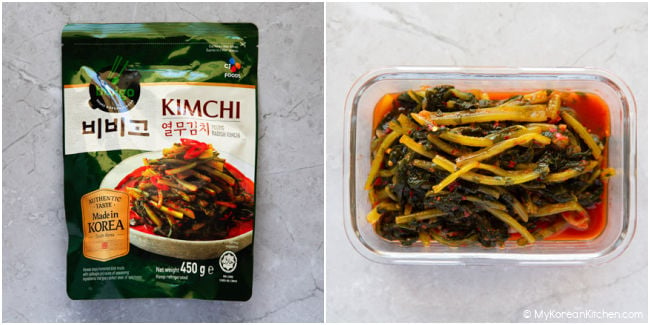
Exploring Alternative Ingredients
If you don’t want to go all in with making true Korean banchan but still want to experience this easy bibimbap, here are some alternative ingredients you could add in your bowl.
- Cucumber, thinly sliced
- Carrots, julienned, use fresh or lightly stir-fried
- Lettuce or other green leaves, chopped
- Avocado, thinly sliced
- Mushrooms, thinly sliced, lightly stir-fried
- Canned tuna, drained
- Tofu, firm, pan-fried
Best Bibimbap Sauce
Gochujang
Normally, I recommend making a special bibimbap sauce for bibimbap. I even have four different variations if you’re feeling adventurous to try them out! But since this bibimbap is all about being easy and effortless, using gochujang straight out of the tub is totally acceptable too. Surprisingly this simple sauce works so well as it is, creating a delicious bibimbap bowl.
Perilla Oil
I love using Korean perilla oil in my yangpun bibimbap, adding it at the end just before mixing everything together. Depending on where you live, it can be a little challenging to find, but it’s worth the effort. If you manage to get your hands on some, give it a try—it truly elevates the flavor of bibimbap by ten times, if not more! Perilla oil has a unique, nutty taste that’s distinct from sesame oil. However, if you can’t find perilla oil, sesame oil is the next best alternative.
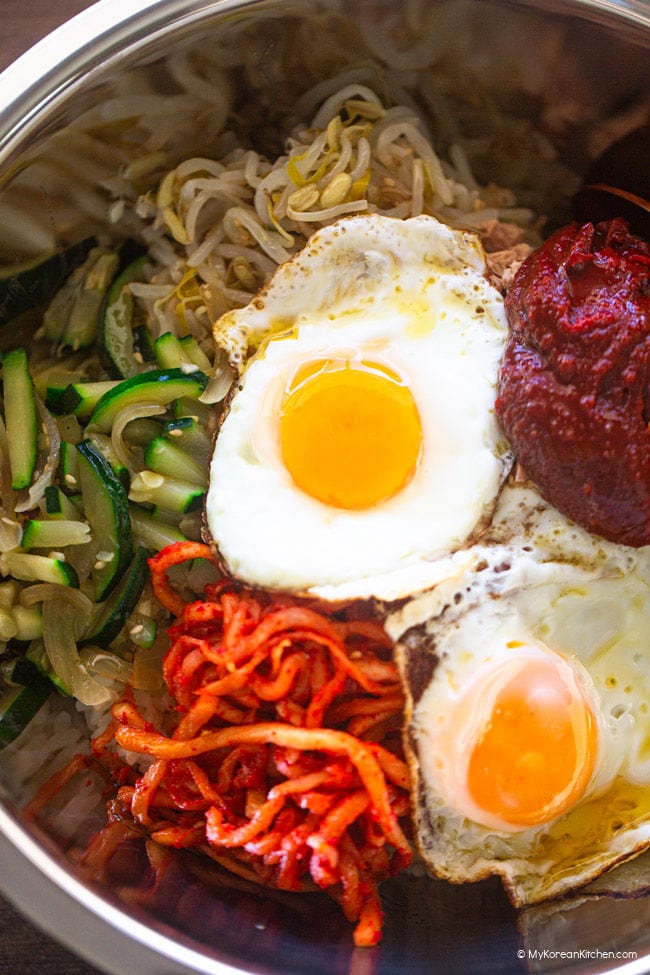
Watch How I Assemble Yangpun Bibimbap (Video)
Just so you know, yangpun bibimbap is often served cold-ish. Even though the rice you add to the bowl might be hot, the rest of the side dishes are often served straight from the fridge and are cold. This is quite normal and expected.
However, if you want to warm up your bibimbap, refer to my dolsot bibimbap recipe, where you can learn how to serve warm bibimbap with a crispy bottom layer of rice. You can even use your cast iron skillet to achieve the dolsot bibimbap effect. 😉
Love Korean food? Explore our site for more authentic Korean recipes including how to create a perfect Korean BBQ at home or other easy Korean recipes. Also, never miss a new recipe by subscribing to our newsletter, and join us in celebrating Korean cuisine!
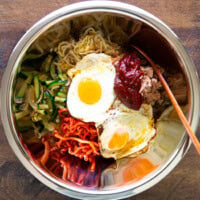
Yangpun Bibimbap
Ingredients
RICE
- 2 to 3 cups Steamed Rice
VEGETABLES AND MEAT
- 100 g Korean Bean Sprout Salad (3.5 ounces)
- 95 g Korean Zucchini Stir Fry (3.4 ounces)
- 115 g Spicy Radish Salad (4.1 ounces)
- 185 g Canned Tuna (6.5 ounces), oil/water, drained
- 2 Pan-Fried Egg , sunny-side up
SAUCE
- 2 Tbsp Gochujang (Korean chili paste), or more
- 1 Tbsp Korean Perilla Oil (or sesame oil)
Instructions
- Prepare your choice of ingredients. (Refer to the main post or the note section below for more ideas.) The ingredients list above shows what's displayed in the picture and video. However, there are no set rules. Ideally, it would be nice to include more than three different types of banchan, vegetables, or meat in your bibimbap bowl to enhance the flavor.
- Place a generous serving of rice into a large mixing bowl (yangpun). Arrange your choice of Korean banchan (side dishes), vegetables, meat, and a fried egg on top of the rice. Add gochujang and drizzle perilla oil (or sesame oil).
- Mix everything thoroughly until well combined. Then, dig in and enjoy!
Notes
- Gosari Namul (Korean Fernbrake Side Dish)
- Sigeumchi Namul (Korean Spinach Salad)
- Oi Namul (sautéed cucumber)
- Oi Muchim (Spicy Korean Cucumber)
- Gamja Bokkeum (Korean Potato Stir Fry)
- Gim (Seasoned and toasted seaweed sheet), crushed
- Kimchi, cut into bite-sized pieces
- Yeolmu Kimchi (Young radish kimchi)
- Cucumber, thinly sliced
- Carrots, julienned, use fresh or lightly stir-fried
- Lettuce or other green leaves, chopped
- Avocado, thinly sliced
- Mushrooms, thinly sliced, lightly stir-fried
- Tofu, firm, pan-fried
The nutrition information shown is an estimate provided by an online nutrition calculator. It should not be considered a substitute for a professional nutritionist’s advice.
